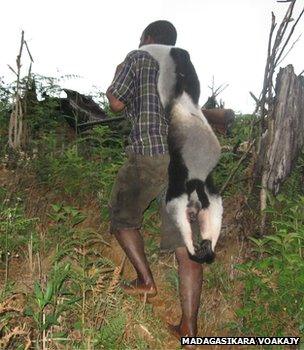Eroding taboos see lemurs end up on dinner tables
- Published

The erosion of fady (taboo) traditions has led to an increase in lemurs being killed for bushmeat
The erosion of traditional cultural taboos in Madagascar has led to an unsustainable number of lemurs being killed for bushmeat, a study suggests.
Locals revered the primates, believing that the animals were family ancestors, but the influx of outside influences has seen a breakdown in these views.
Some species do not reach maturity for up to nine years and produce offspring once every two or three years.
The findings appear in the Public Library of Science (PLoS) One journal, external.
A survey of locals' eating habits by researchers from Bangor University in Wales, and the Malagasy NGO Madagasikara Voakajy showed that hunting of protected species in eastern Madagascar was increasing.
They suggested the rise in illegal hunting was the result of rapid social change, an increase in demand for meat and a decline in traditional taboos.
"When you have globalisation and outside influences, traditional cultures break down and change faster," explained co-author Julia Jones from Bangor University.
"What seems to be happening in some of the remote areas around the nation's eastern rainforests is that a lot of legal gold mining is springing up, so people from outside are moving into the area."
Taboos play an important part in Malagasy culture, she added.
Lemurs, especially indris, have been associated with very strong taboos that traditionally ensured that the primates were not hunted.
For example, one story tells of a man who was looking for honey in the forest when he fell from a tree. Before he hit the ground, he was caught by an indri.
He was so grateful that he went back to the village and said from that moment on, no lemur was to be harmed.
Another belief is that the creatures are ancestors that became lost in the rainforests and turned themselves into lemurs in order to survive.
However, Dr Jones said that although people did not prefer to eat bushmeat, it was often the only meat available.
"If they want meat to eat, there is very poor availability of domestic meat in these rural areas," she told BBC News.
"Chickens suffer terribly from disease in rainforest areas, so do not survive that well - so there is not much protein from domestic animals around."
Dr Jones explained that the influx of people, attracted by job opportunities at the mines, had led to an increase in demand for meat and because people had wages from the mines, small bars that sold bushmeat were opening.
'Shocking' figures
The survey of 1,154 households showed that the majority of meals eaten over a three-day period did not contain any meat at all.
Among the meals that did contain meat, the preference was for fish or domestic animals rather than bushmeat.
Just under 10% of meals consisted of wild-caught animals, and just 0.5% contained meat from protected species.
However, when respondents were asked if they had ever eaten a protected species, 95% said that they had.
And when the team monitored villages to see how much bushmeat was being brought in, they recorded 233 carcasses of Endangered, external indri, the largest species of lemur.
Dr Jones called the figures "shocking", adding that this level of hunting was a major concern for conservation efforts.
"Even if things are being eaten very rarely, if they are very slow-reproducing animals that can be having a huge impact," she said.
"Species like the indri, for example, mature at seven to nine years and then only have one young once every two or three years.
"Primates, in general, are known to be extremely vulnerable to overexploitation."
Christopher Golden, from the Harvard Center for the Environment, US, said the island nation had a rich natural heritage.
"If you look at the mammals especially, which are the main group of animals affected by the bushmeat trade, all the primates - 100% of them - are unique to the island.
Such was the nation's biodiversity, he said, new species were being found all the time.
"I first came to Madagascar in 1990 and there were 34 known species of primates. Now, there are over 100 identified primate species."
However, Dr Golden - who was not involved in the study - added: "We know from our previous studies show hunting is not sustainable in the long run here."
David Attenborough explains how timber and mineral resources are a threat to Madagascar's wildlife.
And here is one major conundrum.
Although unsustainable, the hunting and consumption of non-threatened wildlife in Madagascar is important for human nutrition - particularly for children.
In a recent study published in Proceedings of the National Academy of Sciences (PNAS), external, Dr Golden found that removing "access" to bushmeat for Malagasy families could increase the number of childhood anaemia cases by up to a third.
Dr Jones said improving the availability of alternative meat sources would be one way to overcome the lack of non-bushmeat supplies.
"The fact that people are not eating lemurs as a delicacy means that it is easier to reduce demand through substitutes, such as chickens."
However, she added, this would have to be supported by other projects, including improved veterinary vaccination programmes in order to ensure poultry or livestock did not get wiped out by viruses.
She also said improving the enforcement of existing wildlife laws could also play a role.
"It may not seem to be the most pressing issue facing the country, but wildlife is such an important source of income for Madagascar that tackling this issue should be a priority," Dr Jones observed.
"If the indri and other lemurs disappear from the forests then you are going to get fewer tourists and much less international interest.
"It would be a really positive step and would be worth some investment from the government, given the importance of wildlife to Madagascar's economy."
- Published18 June 2010